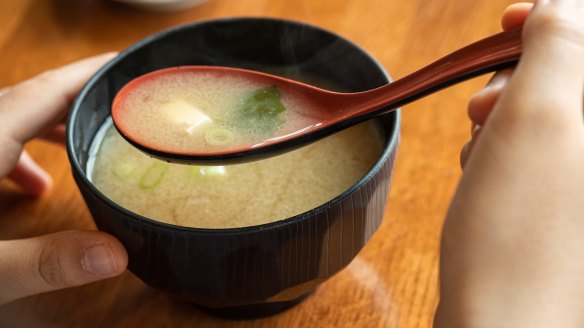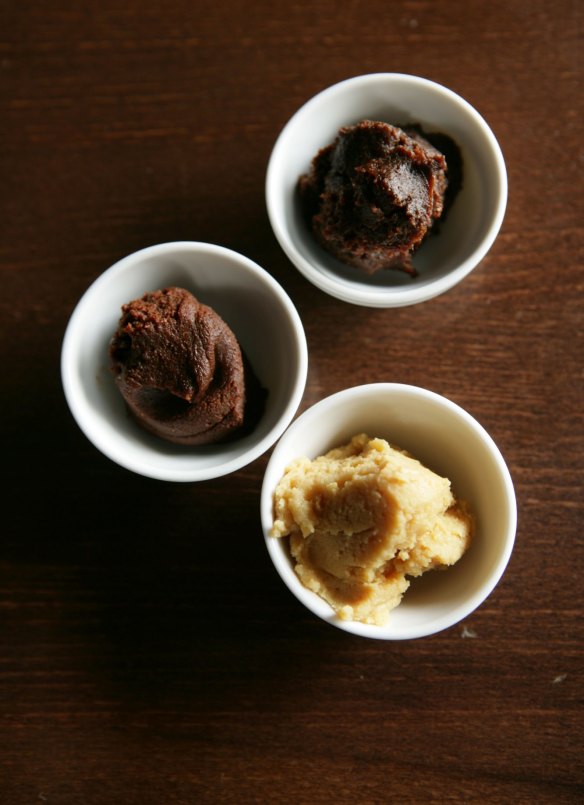Explainer: What's the deal with ... miso?

- Miso collection: 45 umami-packed miso paste recipes
- Adam Liaw's duck and grapefruit salad with honey-miso dressing
From miso eggplant to miso ice-cream, it's hard to miss the Japanese paste's starring role on menus lately. But have you ever thought about what miso really is, and whether it's good for you?
Miso is a seasoning made from fermented soybeans, in the presence of salt and the aspergillus oryzae fungus (koji). It's regularly used to add extra umami kick or a salty-savoury flavour to Japanese or other Asian dishes such as soups, sauces, pickled vegetables or meat.

The ingredient has been popular since before the eighth century, with Sydney accredited practising dietitian Fiona Kupresanin crediting its rising fame to the growing popularity of Japanese cuisine around the world, and more recently to the emerging research around the health benefits of probiotics.
Fellow accredited practising dietitian Fleurette Pereira says historically most people chose miso for its strong flavour profile, remaining largely unaware of its nutritional benefits.
Both dietitians say the rising research around the importance of gut health and miso's ability to contribute to a healthy microbiome has generated new interest in the potential nutritional benefits of the paste.
The longer [miso] has been fermented and aged, the better and higher in umami flavour,Chef Chase Kojima, Sokyo
What are the benefits?
"Miso has huge benefits for gut health due to its high content of beneficial bacteria. It is also a good source of vitamins B, E, K and folic acid," Pereira says.
She says miso supports gut health by providing the body with beneficial bacteria, or probiotics.

"Optimal gut health means improved digestion, immunity and mood. A thriving gut can also lead to reduced constipation, bloating and abdominal discomfort," she says.
Pereira says the fermentation process of miso enhances its nutritional profile.
"[Before it is fermented] miso contains antinutrients. Antinutrients, when consumed, bind to nutrients in your gut and prevent them from being absorbed by the body," she explains.
"As miso is fermented, this reduces the antinutrient content, leading to better digestion and absorption of nutrients," Pereira says.
Kupresanin adds that miso is also a rich source of protein, so is a valuable ingredient in plant-based diets..
Does the research back it up?
While there is limited research around miso itself, the research around fermented foods and their probiotic content is increasing by the day.
We know that fermented foods are excellent sources of probiotics. These beneficial bacteria have attracted a recent wave of scientific interest thanks to researchers' interest in how the gut affects our overall health and wellbeing, including our mood, emotional function, skin health and immune system.
Probiotics are used to help maintain a balance of good and bad gut "bugs", preventing the overgrowth of bad bacteria.
Probiotics can also help break down fibres that would otherwise cause gas or bloating, and help manage constipation, diarrhoea and other symptoms associated with irritable bowel syndrome.
As one recent review published in Tropical Life Sciences Research explains, "There is no doubt that the application of probiotics for human health will expand to a greater degree with the current significant research progress."
Fresh miso is an excellent source of probiotics worth adding to your diet, alongside yoghurt, sauerkraut, kefir, kimchi, tempeh and other fermented foods, Pereira says.
"Be sure to choose one that is unpasteurised, as pasteurised varieties will kill off the beneficial bacteria," she says.
The fine print
As with many soy products, it's important not to overindulge on miso.
Pereira recommends limiting your consumption of soy protein to 25 grams a day as some research suggests soy can mimic the effects of the hormone oestrogen. While the evidence isn't conclusive, dietitians recommend limiting intake to this amount as a precaution.
"This equates to approximately 100 grams of soybeans. If you are unsure, check the food labels," she says.
Miso is also high in sodium, so make sure you don't exceed 2300mg sodium a day, Pereira says.
"Miso can be added in small amounts to soups, vegetables ... to provide maximum flavour and nutritional benefits, therefore if part of a healthy diet, the sodium [content] may not be much of an issue," Pereira says.
Many fermented foods contain high sodium levels but this should not deter people from eating small amounts, Kupresanin says. She also cautions against boiling miso, which may affect its probiotic activity.
Red v white
So which type of miso should you choose, red or white?
"The main differences between red and white miso are in their flavour and duration of fermentation," Pereira says.
She recommends choosing white miso, or shiro miso, if miso is a new addition to your diet.
"It is milder in flavour, lighter in colour and slightly salty. White miso is fermented for a few months," Pereira says.
Red miso, or ana miso, has a richer, saltier flavour after being fermented over several years.
The colour and flavour profiles of each type of miso make them great for experimenting in different styles of recipes.
In the kitchen
Pereira recommends using miso in a salad dressing for soba noodle salad, as a marinade for chicken or protein, or adding it to soups, while Kupresanin uses it in stir-fry sauces.
Good Food columnist and cookbook author Jill Dupleix says miso soup should be rich, aromatic and subtly sweet: "The perfect breakfast for cooler weather when a green smoothie leaves you cold and fruit and yoghurt makes you shiver."
She suggests serving soup with pickles, seaweed, or spicy Japanese togarashi sprinkles. You can also add noodles or brown rice, or build in extra protein with last night's leftover grilled salmon or chicken.
Sydney chef Chase Kojima from Sokyo at The Star says home cooks can use miso in many ways other than soups and marinades. He recommends thinking of miso "like Vegemite", and putting it on toast. He's also a big advocate of miso ice-cream, saying it tastes "like salted caramel if done right".
"I also love curing egg yolk in miso, and pickling vegetables in miso," he says.
Not a big fan of the flavour? Kojima says it doesn't have to be overwhelming, and that adding small amounts to sauces or dressings could subtly elevate a dish and be surprisingly delicious.
He suggests opting for aged miso for maximum flavour.
"The longer it has been fermented and aged, the better and higher in umami flavour," he says. "Supermarket stuff is cheap and good for sauces and dressing, however good quality miso is better if you're using it straight up, like in miso soup and pasting on fish directly."
When it comes to a classic miso soup, Kojima recommends always using a miso soup strainer when adding miso into the soup, to avoid lumps.
"The best results come when you add the miso to the soup last, as you don't want to cook the miso," he suggests.
Kojima says the best stock to use in your miso soup is, of course dashi, but many people use a combination of kombu (dried kelp) and katsuobushi (bonito flakes).
"The best miso soup I've ever had was in Jimbocho Den [in Tokyo], where they only made dashi from aged hon-katsuobushi [and no kombu]," he says.
Silken tofu is usually best for miso soup, too, as it is soft and "has an elegance to it as miso soup is usually light". Red miso soup may sometimes pair well with medium to firm tofu, however.
Most importantly, serve miso soup immediately.
"Miso soup needs to be made and served right away. It can't sit. You can't freeze it or pre-make it and get a good result later," Kojima says.
The future?
Miso is no fad, both dietitians say, and Kupresanin predicts its popularity will grow as more research is conducted on the benefits of probiotic foods.
"With its incredible flavour and standout nutrient profile, miso is definitely here to stay," Pereira says.
The best recipes from Australia's leading chefs straight to your inbox.
Sign up